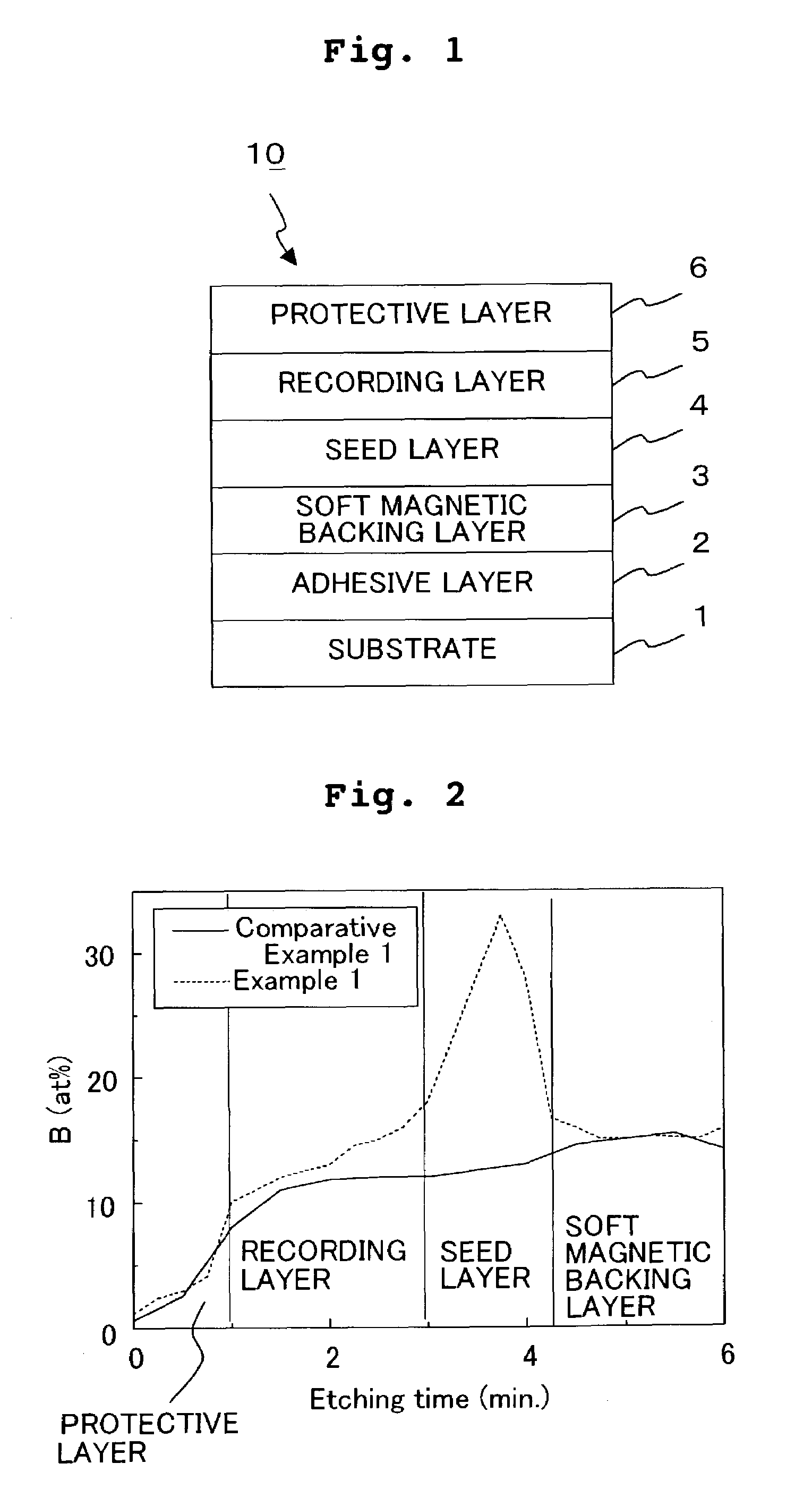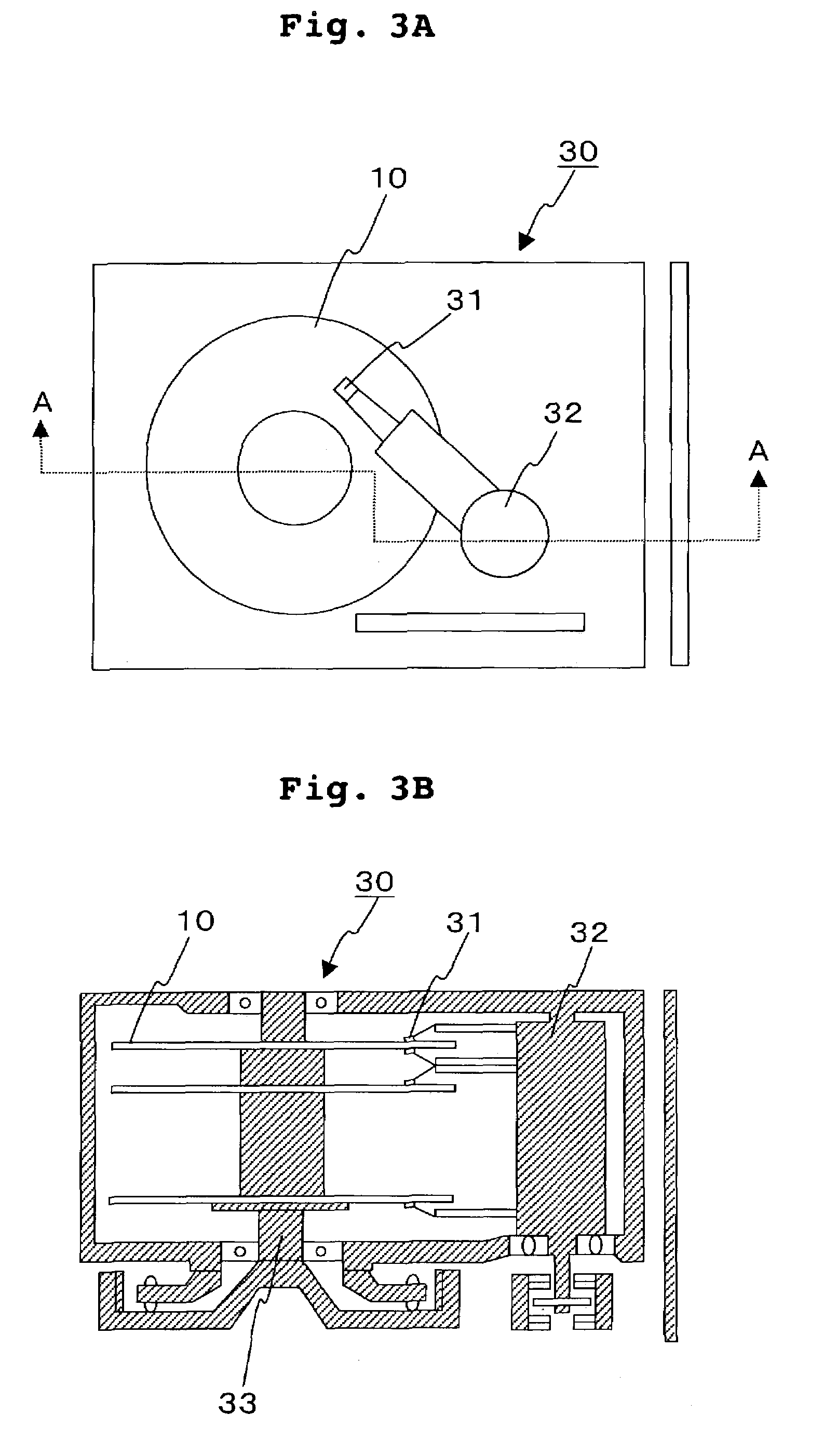Magnetic recording medium, method for producing the same, and magnetic recording apparatus
a recording medium and magnetic recording technology, applied in the field of magnetic recording medium, a method for producing the same, and a magnetic recording apparatus, can solve the problems of increasing the size of the minimum magnetic domain, reducing the thermal stability of the recording magnetization, and increasing the transition noise in the recording transition area, so as to reduce the transition noise, improve the thermal stability, and increase the signal-to-noise ratio (s/n).
- Summary
- Abstract
- Description
- Claims
- Application Information
AI Technical Summary
Benefits of technology
Problems solved by technology
Method used
Image
Examples
example 1
[0031]FIG. 1 shows a schematic sectional view illustrating a magnetic disk manufactured in Example 1. As shown in FIG. 1, the magnetic disk 10 was manufactured by successively stacking, on a substrate 1, an adhesive layer 2, a soft magnetic backing layer 3, a seed layer 4, a recording layer 5, and a protective layer 6. The adhesive layer 2 is the layer for avoiding any exfoliation between the substrate 1 and the stacked films. The soft magnetic backing layer 3 is the layer for steeping the magnetic field to be applied to the recording layer 5 during the recording of information. The seed layer 4 is the layer for forming the recording layer 5 on the seed layer 4 so that the crystal grains of the recording layer 5 are uniform in size. The recording layer 5 is the layer for recording information as magnetization information. The direction of magnetization of the recording layer 5 is in the vertical direction with respect to the film surface. The protective layer 6 is the layer for prot...
example 2
[0049]In Example 2, a variety of magnetic disks were manufactured in the same manner as in Example 1 except that the magnetic disks were manufactured by changing the B content of the seed layer within a range of 33.0 to 100.0 at. % and the B content of the recording layer within a range of 5.0 to 15.0 at. % respectively upon the film formation of the magnetic disks.
[0050]Slf / Nd was measured for the variety of magnetic disks manufactured in this embodiment in the same manner as in Example 1. Obtained results are shown in Table 2. In Table 2, BR represents the B content upon the film formation of the recording layer, BS represents the B content upon the film formation of the seed layer, B1 represents the B concentration in the vicinity of the boundary surface between the recording layer and the seed layer after the film formation, and B2 represents the B concentration at the intermediate position between the boundary surface of the recording layer disposed on the side of the seed laye...
example 3
[0053]In Example 3, a magnetic disk was manufactured in the same manner as in Example 1 except that the sputtering was performed by mixing oxygen at a flow rate ratio of 0.5% by volume with respect to the Ar gas during the film formation of the recording layer. The composition of the obtained recording layer in the film thickness direction was investigated by means of the Auger electron spectroscopy (AES). As a result, it was revealed that oxygen was contained in an amount of about 3 at. % as represented by the composition ratio. Slf / Nd was measured for the magnetic disk manufactured in this embodiment in the same manner as in Example 1. As a result, Slf / Nd=25 dB was obtained, i.e., the value higher than that of Slf / Nd of the magnetic disk of Example 1 was obtained, for the following reason. That is, it is considered that oxygen is contained in the recording layer by mixing the small amount of oxygen in the sputtering gas during the film formation of the recording layer, and thus th...
PUM
 Login to View More
Login to View More Abstract
Description
Claims
Application Information
 Login to View More
Login to View More - R&D
- Intellectual Property
- Life Sciences
- Materials
- Tech Scout
- Unparalleled Data Quality
- Higher Quality Content
- 60% Fewer Hallucinations
Browse by: Latest US Patents, China's latest patents, Technical Efficacy Thesaurus, Application Domain, Technology Topic, Popular Technical Reports.
© 2025 PatSnap. All rights reserved.Legal|Privacy policy|Modern Slavery Act Transparency Statement|Sitemap|About US| Contact US: help@patsnap.com



